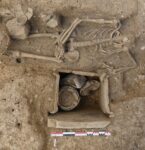 A cemetery dating to the 1st-2nd century A.D. with an unusual variety of burial types has been discovered in Nîmes, southern France. So far the interred remains of fifty individuals have been recorded, laid to rest in inhumation burials, cremation urns and funerary pyres. The graves contain an array of grave goods, primarily pottery, in excellent condition.
A cemetery dating to the 1st-2nd century A.D. with an unusual variety of burial types has been discovered in Nîmes, southern France. So far the interred remains of fifty individuals have been recorded, laid to rest in inhumation burials, cremation urns and funerary pyres. The graves contain an array of grave goods, primarily pottery, in excellent condition.
Absorbed into the modern city of Nîmes in the 18th century, the area under excavation was just outside the southern perimeter of the ancient city. It was less than 165 feet from the Augustan-era city walls and one of the main gates was less than a couple hundred feet west along the wall. The neighborhood has been neglected archaeologically until now, so the excavation has shed new light on the little-known history of peri-urban spaces of Roman towns.
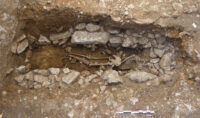 The earliest remains found in the dig were agricultural: furrows (sulci in Latin) that were dug to plant vines. They have not been conclusively dated, but they pre-date the funerary use of the space in the 1st century A.D. Of the fifty individuals identified in the burial, all but two are adults. The tombs are divided into groupings, but only two of them on the western side are clearly delineated. The eastern side, which contains most of the burials, is more ambiguously arranged, but one section has the remains of walls outlining an enclosure that contains at least seven burials.
The earliest remains found in the dig were agricultural: furrows (sulci in Latin) that were dug to plant vines. They have not been conclusively dated, but they pre-date the funerary use of the space in the 1st century A.D. Of the fifty individuals identified in the burial, all but two are adults. The tombs are divided into groupings, but only two of them on the western side are clearly delineated. The eastern side, which contains most of the burials, is more ambiguously arranged, but one section has the remains of walls outlining an enclosure that contains at least seven burials.
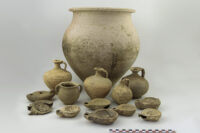 There are a number of wooden coffin inhumations. The wood is gone, but the iron nails remain in place. The coffins were then placed in cut graves. Stone blocks were added outside the coffin; some thickly line the grave walls. One coffin burial was placed in a stone-lined grave and topped with a cover slab. In this grave the deceased was unusually positioned on his side facing east, as if he were reclining for his final funerary banquet. Another inhumation has a secondary cremation deposit built into it. To the deceased’s left (south) is a coffer lined with ceramic tiles containing a cinerary urn and grave goods.
There are a number of wooden coffin inhumations. The wood is gone, but the iron nails remain in place. The coffins were then placed in cut graves. Stone blocks were added outside the coffin; some thickly line the grave walls. One coffin burial was placed in a stone-lined grave and topped with a cover slab. In this grave the deceased was unusually positioned on his side facing east, as if he were reclining for his final funerary banquet. Another inhumation has a secondary cremation deposit built into it. To the deceased’s left (south) is a coffer lined with ceramic tiles containing a cinerary urn and grave goods.
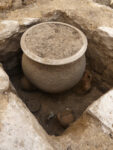 One remarkable cinerary vase, which is very large and in excellent condition, was found inside a masonry loculus (a niche made to contain funerary remains). Before the large vessel was placed in the loculus, a small ceramic vase was broken and used as the foundation for the ossuary. Two jugs, one ceramic vase, one ceramic oil lamp and one small glass balsamarium (unguent/perfume jar) were then added on the sides and in front of the ossuary which towers over them.
One remarkable cinerary vase, which is very large and in excellent condition, was found inside a masonry loculus (a niche made to contain funerary remains). Before the large vessel was placed in the loculus, a small ceramic vase was broken and used as the foundation for the ossuary. Two jugs, one ceramic vase, one ceramic oil lamp and one small glass balsamarium (unguent/perfume jar) were then added on the sides and in front of the ossuary which towers over them.
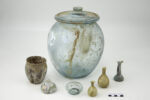
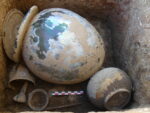 Another exceptional cremation burial consists of a coffer cut out of a single stone containing a precious glass cinerary vase topped by its glass lid still in place, both intact. Inside the coffer with the urn is a ceramic jug, an oil lamp, a cup, a goblet, another glass balsamarium, three wooden styluses, a fragment of faunal bone and two bronze mirrors.
Another exceptional cremation burial consists of a coffer cut out of a single stone containing a precious glass cinerary vase topped by its glass lid still in place, both intact. Inside the coffer with the urn is a ceramic jug, an oil lamp, a cup, a goblet, another glass balsamarium, three wooden styluses, a fragment of faunal bone and two bronze mirrors.